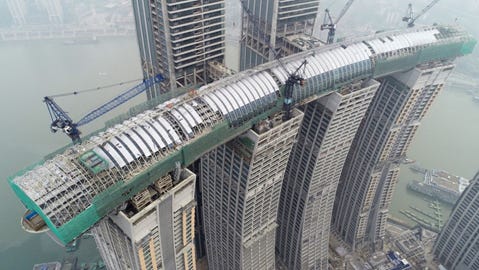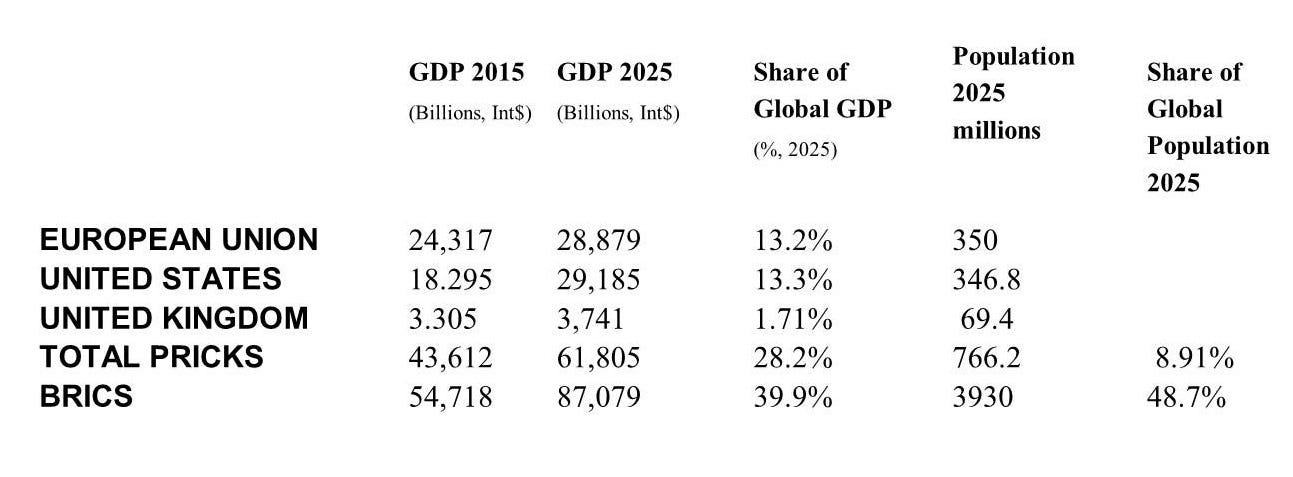Coming into 2025, the BRICS have a greater share of the economic pie, six times the population digesting the pie, and are growing in principal categories — GDP/PPP, population, and adherents at a faster rate.
The Pricks devalue the Brics by claiming they are a loose and uncoordinated confederation, unable to agree on vital issues. Brazil is accused of harassing former President Jair Messias Bolsonaro and may be subjected to sanctions; Russia is led by an irresponsible tyrant and is heavily sanctioned; India gets a pass despite the heavy-handed tactics toward its Muslim community; China is led by a despotic dictator, and South Africa is guilty of genocide toward its white population.
The Pricks pose themselves as a model of decency and decorum. They have ballot boxes and freedom of speech, which enables their citizens to elect the biggest pricks and then freely criticize their selections by vocal erections. In the U.S. the next presidential election process — fund raising, organization, public relations, the “eye on the prize”— starts shortly after a new president takes office. Winning candidates in elections expend more time and energy in gaining victory and preparing for their next victory than performing their duties during their term in office.
The economic, social, and political advancements of their principal superpowers, China for the BRICS and the United States for the Pricks, determine the success of the BRICS and the Pricks. A brief examination of each nation’s potential to rise in the firmament or descend into chaos tells the story.
The Trump administration shows the hidden failures of the United States pluralistic democracy. The past has no continuity; just the opposite, many of the legislations from previous administrations are discarded. and the country, rather than advancing to a progressed new, returns to a rejected old. One example from Understanding AI:
…. Sen. Hawley asked Donald Trump to cancel a federal loan guarantee for the Grain Belt Express, an $11 billion transmission line that is supposed to carry electricity from Kansas wind farms to homes in Illinois and Indiana. The proposed line would pass through Hawley’s state of Missouri, annoying farmers whose land would be taken by eminent domain.
According to the New York Times, Hawley “explained his concerns to the president, who has repeatedly expressed his distaste for wind power, saying he would not permit any new wind projects during his administration.” Trump then called Energy Secretary Chris Wright, who agreed to cancel a federal loan guarantee for the project, throwing its viability into question.
Impulse overrides soul searching, allegiance to leader is more important than professional education and experience; rash and subjective action replaces careful thought. The America of 2025, with its decaying infrastructure, troubled inner cities, dependence on fossil fuels, continuous problems of crime, drug addiction, health care, and immigration, closely resembles the America of 2010. One big difference ─ adversity and polarization of the population has increased, Americans are at the breaking point with one another. The country, which is rich in resources, has extensive farmland, enjoys suitable and varied climates, and contains an educated and diligent population, is not well managed; it is mismanaged.
The Xi JInping administration shows the hidden success of China’s people’s democracy. The past has continuity; legislations and plans from previous administrations are massaged and enhanced, and the country, rather than remaining stagnant, advances to a new level. Soul searching from millions of cadres provides suggestions for millions of improvements. All leaders have professional education and experience; careful thought displaces rash and subjective action.
The China of 2025, with its continually increasing infrastructure of roads, bridges, tunnels, dams, superhighways, high speed trains, and airline routes that link every remote place in China with central cores, with modern building complexes that replace the shanty towns and provide agreeable living space for an aging population and marginalized rural farmers, with its expanded megacities that are considered technology and planning marvels, and with a unified and obedient population ─ no adversity or polarization here ─ has only a fleeting resemblance to the China of 2010.
 Dubbed an engineering marvel, the highly anticipated Raffles City Chongqing project is nearly complete. CapitaLand Group
Dubbed an engineering marvel, the highly anticipated Raffles City Chongqing project is nearly complete. CapitaLand Group
Sheltering their deficiencies, the Western democracies shift the critical analysis to public relations stunts that highlight the supposed and exaggerated deficiencies of the Chinese system. The Westerners make no effort to learn and understand the workings of China’s political, social, and economic systems. Fabrications are added to the limited “don’t care to know” and conveyed to the public as authorized knowledge. One example is the “debt trap” verbiage, applied to Chinese lending, which began during Sri Lanka’s first debt crisis and has stuck around as an effective means to vilify the PRC.
We have the falsehood. Washington Post (WAPO), “This China has a hand in Sri Lanka’s economic calamity,” analysis by Ishaan Tharoor, July 20, 2022:
One of the major players in Sri Lanka’s calamity is China. Beijing is Sri Lanka’s lone biggest creditor, accounting for some 10 percent of the country’s foreign debt. Between 2000 and 2020, it extended close to $12 billion in loans to the Sri Lankan government, largely for a slate of major infrastructure projects that turned into white elephants — including a costly port facility in the Rajapaksas’ hometown of Hambantota, which was effectively ceded to Chinese control half a decade ago after Sri Lankan authorities recognized they could no longer pay off the loans.
Examination of the Sri Lanka debt crisis exposes the mendacity and viciousness of the WAPO report. Almost every sentence is spurious; China does not engage in “debt trap diplomacy” and has been one lender who makes financial sacrifices that rescues nations from debilitating borrowing.
We have the truth. The Atlantic, “The Chinese ‘Debt Trap’ Is a Myth,” by Deborah Brautigam and Meg Rithmire, February 6, 2021, had already contradicted WAPO statements.
Steep payments on international sovereign bonds, which comprised nearly 40 percent of the country’s external debt, put Sirisena’s government in dire fiscal straits almost immediately. When Sirisena took office, Sri Lanka owed more to Japan, the World Bank, and the Asian Development Bank than to China. Of the $4.5 billion in debt service Sri Lanka would pay in 2017, only 5 percent was because of Hambantota. The Central Bank governors under both Rajapaksa and Sirisena do not agree on much, but they both told us that Hambantota, and Chinese finance in general, was not the source of the country’s financial distress.
There was also never a default. Colombo arranged a bailout from the International Monetary Fund and decided to raise much-needed dollars by leasing out the underperforming Hambantota Port to an experienced company—just as the Canadians had recommended. There was not an open tender, and the only two bids came from China Merchants and China Harbor. Sri Lanka chose China Merchants, making it the majority shareholder with a 99-year lease, and used the $1.12 billion cash infusion to bolster its foreign reserves, not to pay off China Eximbank. The China impressed on our minds is not the China that exists.
The United States moves on fumes, on the energies of its past without renewable energies for an improved future. China moves on constantly reinforced energy, all engines operating at top speed, each day becoming a new future. The Pricks know they will not be able to compete economically with the BRICS. They have a choice of consolidating and working together and maintaining reduced economies, cooperating with the Brics in mutual agreements, or, by the usual United States method, resolving the situation by military action.
The threat of military force alarms and subdues the BRICS. They may be compelled to yield much in order to save all. China, guided by its Mandate of Heaven, “a political and religious doctrine that justifies the rule of an emperor based on virtue and ability to govern,” and which it has extended to relations between all nations, might do what it did in the fifteenth century. At that time, China was, by far, the leading commercial power in the world, and huge Chinese fleets sailed the world for markets for its surplus products. After meeting the imperial powers of France, Great Britain, and the Netherlands and observing their nefarious methods in subduing the Africa and Indian peoples, stripping them of resources, and forcing upon them the products manufactured from the resources, China scuttled its fleet and went into solitary confinement.
The reason for Xi Jinping’s self-sufficiency drive is clear. Save the world from nuclear conflagration and let the rest of the world rot. Pricks always lose and always think they have won.

 Dubbed an engineering marvel, the highly anticipated Raffles City Chongqing project is nearly complete. CapitaLand Group
Dubbed an engineering marvel, the highly anticipated Raffles City Chongqing project is nearly complete. CapitaLand Group